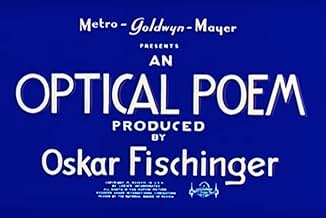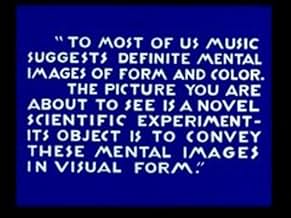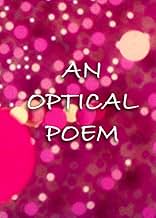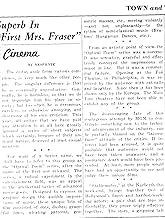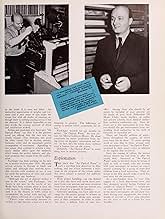Adicionar um enredo no seu idiomaMental imagery of music is visualized with two-dimensional shapes dancing to the rhythm of Franz Liszt's Hungarian Rhapsody No. 2.Mental imagery of music is visualized with two-dimensional shapes dancing to the rhythm of Franz Liszt's Hungarian Rhapsody No. 2.Mental imagery of music is visualized with two-dimensional shapes dancing to the rhythm of Franz Liszt's Hungarian Rhapsody No. 2.
- Direção
Avaliações em destaque
This is from a collection of art films entitled "Unseen Cinema: Early American Avant-Garde Film 1894-1941". Unlike most of the other films in this set, this one is from a major studio--MGM. Somehow Oskar Fischinger was able to convince the MGM folks to sponsor this art film that consists of hundreds of paper cut-outs that are hung from invisible wires and which are shot, one frame at a time---all in synchronization with music from Franz Liszt. It's all in color and it's amazing that such a non-commercial sort of project was funded by this or any studio.
While it's not at all fun, it is an amazing film to watch. Not only is it wonderfully synchronized, but works so very well. It's all very hypnotic and amazing--even when you see it today. It must have taken forever practically to make this--and perhaps this is why this is Fischinger's only film. Strange but well worth seeing.
While it's not at all fun, it is an amazing film to watch. Not only is it wonderfully synchronized, but works so very well. It's all very hypnotic and amazing--even when you see it today. It must have taken forever practically to make this--and perhaps this is why this is Fischinger's only film. Strange but well worth seeing.
What makes me chuckle about this short film is that MGM actually financed it! Who'd have thought that such attitudes were ever present at the big studios? The intertitle at the start calls the movie a "scientific experiment"*, gawd those guys were dumb. Anyway they let Fischinger get on with his business so I can't complain. The second time I watched it I really was dumbfounded by the MGM logo, for once, ars gratia artis actually meant something! Anyway the film is a visual accompaniment to Liszt's Hungarian Rhapsody no.2. Fischinger chose his music really well because there are lots of sea changes within the piece that allows him to do something totally different at the mood switches. He uses coloured paper circles and stop motion animation, to create a geometrical ballet. He must have done a lot of work because the movements are all very smooth. In fact it's really a masterpiece of technical craft and almost unbelievable how synchronised the animation is to the music.
It brought a big smile to my face and that's really rare.
* "To most of us, music suggests definite mental images of form and colour. The picture you are about to see is a novel scientific experiment. Its object is to convey these mental images in visual form"
It brought a big smile to my face and that's really rare.
* "To most of us, music suggests definite mental images of form and colour. The picture you are about to see is a novel scientific experiment. Its object is to convey these mental images in visual form"
Abstract images float across the field in time to Liszt's Second Hungarian Rhapsody.
Oskar Fischinger had been producing this sort of abstract animation since 1924 in Germany as an outgrowth of the Dadaist movement. He was not the only film maker to at least dabble in this sort of work. Over in England, Len Lye started doing the same thing with the introduction of sound to films, and later, Norman McLaren would make several of his early shorts doing much the same. In fact, a couple of years after this came out, part of FANTASIA would do the same. It was a natural outgrowth of abstract art and program music, in which the music was meant to evoke emotions or scenes or even stories. They didn't call them etudes for no reason, but because they evoked enquiring thoughts. Only with abstract animation like this, the audience was called upon to go its own way, and perhaps afterwards discuss what it was all about.
Pretty colors, though. It reminds me of the days I was part of the light show crew at the Fillmore East.
Oskar Fischinger had been producing this sort of abstract animation since 1924 in Germany as an outgrowth of the Dadaist movement. He was not the only film maker to at least dabble in this sort of work. Over in England, Len Lye started doing the same thing with the introduction of sound to films, and later, Norman McLaren would make several of his early shorts doing much the same. In fact, a couple of years after this came out, part of FANTASIA would do the same. It was a natural outgrowth of abstract art and program music, in which the music was meant to evoke emotions or scenes or even stories. They didn't call them etudes for no reason, but because they evoked enquiring thoughts. Only with abstract animation like this, the audience was called upon to go its own way, and perhaps afterwards discuss what it was all about.
Pretty colors, though. It reminds me of the days I was part of the light show crew at the Fillmore East.
I appreciated the soundtrack more than the abstract art, patterns of balloon-shaped dots that dance across the screen for six minutes while the 2nd Hungarian Rhapsody explodes with musical sounds.
After a few minutes, the short becomes too repetitious to be really novel. In fact, it's the sort of thing the Disney studio was already experimenting with and led to several short subjects, as well as the full-length feature "Fantasia" later on, combining classical music with unique animation.
But this was 1937 and the comparison to Disney was not made at the time. Nevertheless, I found it monotonous to watch and not unique enough, except for the exhilarating classical music performed.
After a few minutes, the short becomes too repetitious to be really novel. In fact, it's the sort of thing the Disney studio was already experimenting with and led to several short subjects, as well as the full-length feature "Fantasia" later on, combining classical music with unique animation.
But this was 1937 and the comparison to Disney was not made at the time. Nevertheless, I found it monotonous to watch and not unique enough, except for the exhilarating classical music performed.
It's an MGM animated short with Hungarian Rhapsody No. 2 by Franz Liszt playing. It's Technicolor. It's all bright colors and geometric shapes. It's a little experimental. It's interesting. Sometimes, the movement is pretty good, but other times, I want it to switch with the music tempo a lot more. One of the most compelling aspect of this piece of music is its many changes of tempo. The visuals need to match that better. This type of animated experiments have a long Hollywood history. Producer Oskar Fischinger would go on to do a sequence in Walt Disney's Fantasia (1940) which obviously drew inspiration from this.
Você sabia?
- CuriosidadesAs this was released two years before "Fantasia," it's reasonable to assume either Disney or someone who worked for him saw this and realized the possibilities of non-narrative animation set to classical music; certainly the "Toccata and Fugue in D Minor" sequence bears a striking similarity.
- Citações
Prologue (Title): To most of us music suggests definite mental images of form and color. The picture you are about to see is a novel scientific experiment - Its object is to convey these mental images in visual form.
Principais escolhas
Faça login para avaliar e ver a lista de recomendações personalizadas
Detalhes
- Data de lançamento
- País de origem
- Idioma
- Também conhecido como
- MGM Miniatures (1937-1938 Season) #5: An Optical Poem
- Empresa de produção
- Consulte mais créditos da empresa na IMDbPro
- Tempo de duração
- 6 min
- Proporção
- 1.37 : 1
Contribua para esta página
Sugerir uma alteração ou adicionar conteúdo ausente

